Tornadoes
Before
Know the Signs
Tornadoes can form quickly, often with little warning. Be alert to:
- A rotating, funnel-shaped cloud
- A loud roar that may sound like a freight train
- An approaching cloud of debris
Stay Informed
- Sign up for local warning systems and alerts like the Emergency Alert System (EAS) and NOAA Weather Radio.
- Know the difference between a Tornado Watch (conditions are favorable) and a Tornado Warning (a tornado has been sighted or indicated by radar).
- Monitor local TV, radio, and official social media channels for updates.
Prepare Your Home and Family
- Identify a safe place in your home: a basement, storm cellar, or small, interior room on the lowest level of a sturdy building—away from windows and outside walls.
- Practice tornado drills with your family so everyone knows where to go.
- Make sure your disaster supply kit includes:
- Flashlight with extra batteries
- Battery-powered radio
- First aid kit and medications
- Non-perishable food and water
- Sturdy shoes and essential tools
- Cash or credit cards
- Include pets in your emergency plans.
- Remove dead or weak tree branches near your home to minimize wind damage.
During
If Indoors
- Go immediately to a safe space.
- Stay away from windows, doors, and exterior walls.
- Cover your head and neck with your arms and put materials such as furniture and blankets around or on top of you.
- Continue listening to weather updates via a battery-operated radio or app.
If Outdoors
- Seek shelter in a building or vehicle if possible.
- If no shelter is available, move to a low, open area. Avoid trees, tall objects, and metal items.
- Stay away from bodies of water like rivers or lakes.
- Crouch low to the ground with your hands on your knees.
- Avoid isolated tall trees, fences, power lines, and metal objects such as golf clubs, bicycles, or equipment.
If in a Vehicle
- Park your car safely out of traffic.
- Stay in the car, seatbelt on, head below window level. Cover your head.
- If you can get to a low area noticeably lower than the roadway, exit the vehicle and lie flat, covering your head.
Important: Avoid taking shelter under bridges or overpasses.
After
Stay Safe
- Keep listening to NOAA Weather Radio or local authorities for emergency information and instructions.
- Avoid downed power lines and report them immediately.
Check for Injuries
- Administer first aid if trained, and call emergency services as needed.
- A person struck by lightning or debris is safe to touch - do not delay assistance.
Communicate Safely
- Use text messages or social media to check in with loved ones.
Driving
- Drive only if necessary.
- Debris and washed-out roads may make driving dangerous.
Enhanced Fujita Scale
Forecasters and researchers use a wind damage scale to classify tornadoes. The original Fujita scale was developed by T. Theodore Fujita and was put into use in 1973. The scale was enhanced in 2007, with rankings running from EF (Enhanced Fujita) 0-5. The ratings were based on the amount and type of wind damage.
| EF Rating | Wind Speeds | Expected Damage | |
|---|---|---|---|
| EF-0 | 65-85 mph | 'Minor' Damage: Shingles blown off or parts of a roof peeled off, damage to gutters/siding, branches broken off trees, shallow rooted trees toppled. | 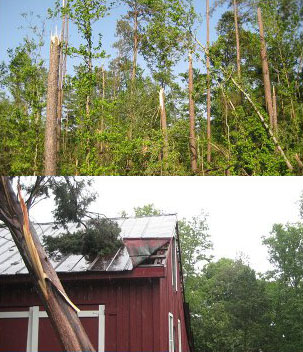 |
| EF-1 | 86-110 mph | 'Moderate' Damage: More significant roof damage, windows broken, exterior doors damages or lost, mobile homes overturned or badly damaged. | 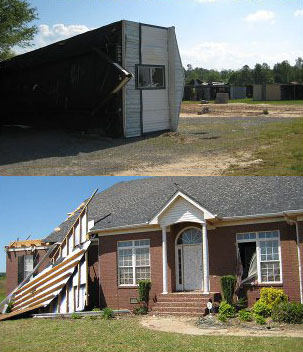 |
| EF-2 | 111-135 mph | 'Considerable' Damage: Roofs torn off well constructed homes, homes shifted off their foundations, mobile homes completely destroyed, large trees snapped or uprooted, cars can be tossed. | 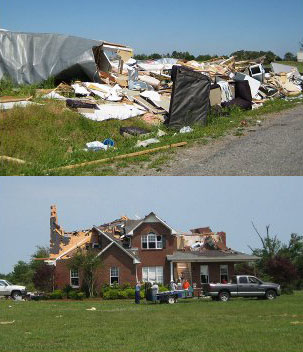 |
| EF-3 | 136-165 mph | 'Severe' Damage: Entire stories of well constructed homes destroyed, significant damage done to large buildings, homes with weak foundations can be clown away, trees begin to lose their bark. | 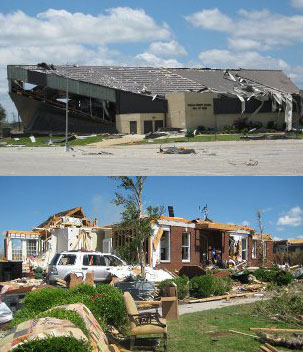 |
| EF-4 | 166-200 mph | 'Extreme' Damage: Well constructed homes are leveled, cars are thrown significant distances, top story exterior walls of masonry buildings would likely collapse. | 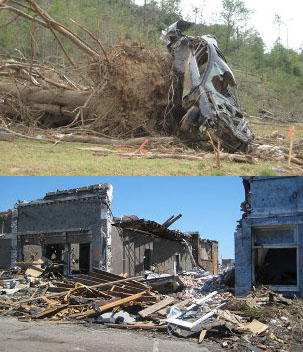 |
| EF-5 | > 200 mph | 'Massive/Incredible' Damage: Well constructed homes are swept away, steel-reinforced concrete structures are critically damaged, high-rise buildings sustain severe structural damage, trees are usually completely debarked, stripped of branches, and snapped. | 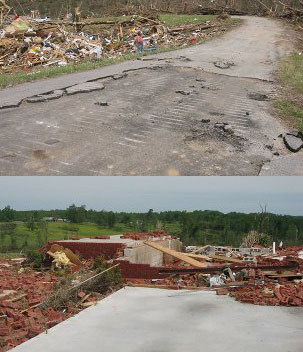 |
Source: National Oceanic and Atmospheric Administration (NOAA)

